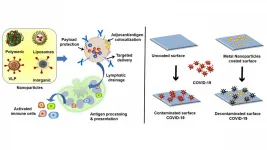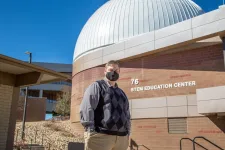The pandemic lockdown leads to cleaner city air across Canada, Concordia paper reveals
A study led by master's student Xuelin Tian examining emission levels shows a sharp drop in vehicle pollutants as of March 2020
2021-02-09
(Press-News.org) The COVID-19 pandemic that shuttered cities around the world did not just affect the way we work, study and socialize. It also affected our mobility. With millions of workers no longer commuting, vehicle traffic across Canada has plummeted. This has had a significant impact on the quality of air in major Canadian cities, according to a new study by Concordia researchers.
A paper published in the journal Science of the Total Environment looked at downtown air quality monitoring station data from Vancouver, Edmonton, Saskatoon, Winnipeg, Toronto, Montreal, Halifax and St. John's. It compared the cities' concentration levels of nitrogen dioxide, carbon monoxide and sulfur dioxide measured between February and August 2020 to the figures recorded over the same period in 2018 and 2019. They also used satellite imagery and urban transportation fuel consumption figures to investigate emissions traffic congestion data provided by tracking technology embedded in phones and cars worldwide.
Not surprisingly, the researchers found that emission levels dropped dramatically over the course of the pandemic. The most noticeable drop-off occurred in week 12 of 2020 -- the one beginning Sunday, March 15, when national lockdown measures were implemented.
"We saw traffic congestion levels decrease by 69 per cent in Toronto and by 75 per cent in Montreal, compared to the same week in 2019," says the paper's lead author, Xuelin Tian, a second-year MSc student at the Gina Cody School of Engineering and Computer Science. Her co-authors include fellow student Zhikun Chen, her supervisor Chunjiang An, assistant professor in the Department of Building, Civil and Environmental Engineering, and Zhiqiang Tian of Xi'an Jiaotong University in China.
Less gasoline means less pollution
The paper notes that motor gasoline consumption fell by almost half during the pandemic's early weeks, with a similar, corresponding drop seen in carbon dioxide emissions. Motor gasoline consumption added 8,253.52 million kilograms of carbon dioxide to the atmosphere in April 2019, according to the authors' data. That number dropped to 4,593.01 million kilograms in April 2020.
There have also been significant drops in the concentration levels of nitrogen dioxide in Vancouver, Edmonton, Toronto and Montreal since the beginning of the pandemic. Similarly, concentration levels of carbon monoxide, closely linked to the transportation and mobile equipment sectors, dropped. In Edmonton, carbon monoxide concentration levels fell by as much as 50 per cent, from 0.14 parts per million in March 2018 to 0.07 in March 2020.
Emissions began to grow again over the summer, but the researchers have not yet had a chance to examine data from the second lockdown that began in late fall/winter 2020.
Aside from providing a kind of snapshot of a particularly unusual period, the data can also help governments assess the long-term impact of replacing gas-burning vehicles with electric ones on Canadian city streets.
"This pandemic provided an opportunity for scenario analysis, although it wasn't done on purpose," says An, Concordia University Research Chair in Spill Response and Remediation.
"Governments everywhere are trying to reduce their use of carbon-based fuels. Now we have some data that shows what happens when we reduce the number of gasoline-powered vehicles and the effect that has on emissions."
INFORMATION:
The Natural Sciences and Engineering Research Council of Canada (NSERC) provided support for this study.
[Attachments] See images for this press release:

ELSE PRESS RELEASES FROM THIS DATE:
2021-02-09
To achieve target delivery of drugs to cells and organs, scientists have to be able to transport the molecules of pharmaceutical substances to targets using a controllable carrier. The role of such a carrier can be played by special particles, such as lipid droplets or magnetic nanoparticles. Among the latter, the most popular are the ones based on iron oxides. Their sizes range from 1 to 100 nm, which is dozens of times smaller than animal cells, and they can be moved within a body using an external magnetic field.
However, in practice, it is quite difficult to control nanoparticles with magnets, as the magnetic field quickly becomes weaker when the distance from the magnet increases. This problem ...
2021-02-09
WASHINGTON, February 9, 2021 -- As COVID-19 spreads via respiratory droplets, researchers have become increasingly interested in the drying of droplets on impermeable and porous surfaces. Surfaces that accelerate evaporation can decelerate the spread of the COVID-19 virus.
In Physics of Fluids, by AIP Publishing, researchers from IIT Bombay show a droplet remains liquid for a much shorter time on a porous surface, making it less favorable to survival of the virus.
The researchers found the coronavirus can survive for four days on glass, seven days on plastic, and seven days on stainless steel. But on paper and cloth, the virus survived for only three hours and two days, respectively.
"Based on our study, we recommend that furniture in hospitals and offices, ...
2021-02-09
What The Study Did: Researchers examined how common SARS- CoV-2 infection was among migrant workers in Singapore.
Authors: Vernon J. Lee, M.B.B.S., Ph.D., of the Ministry of Health in Singapore, is the corresponding author.
To access the embargoed study: Visit our For The Media website at this link https://media.jamanetwork.com/
(doi:10.1001/jama.2020.24071)
Editor's Note: The article includes conflict of interest and funding/support disclosures. Please see the article for additional information, including other authors, author contributions and affiliations, conflict of interest and financial disclosures, and funding and support.
INFORMATION:
Media advisory: The full article is linked to this news release.
Embed ...
2021-02-09
WASHINGTON, February 9, 2021 -- The detailed physical processes and pathways involved in the transmission of COVID-19 are still not well understood. Researchers decided to use advanced computational fluid dynamics tools on supercomputers to deepen understanding of transmission and provide a quantitative assessment of how different environmental factors influence transmission pathways and airborne infection risk.
A restaurant outbreak in China was widely reported as strong evidence of airflow-induced transmission of COVID-19. But it lacked a detailed investigation about exactly how transmission occurred.
Why did some people get infected while others within the same area did not? ...
2021-02-09
What The Viewpoint Says: The missteps and miscommunications that have stymied a more effective U.S. and global response to the COVID-19 pandemic bring into sharp focus the deficiencies in governance systems of the U.S. public health and scientific institutions.
Authors: K. M. Venkat Narayan, M.D., M.Sc., of the Rollins School of Public Health and School of Medicine at Emory University in Atlanta, is the corresponding author.
To access the embargoed study: Visit our For The Media website at this link https://media.jamanetwork.com/
(doi:10.1001/jama.2020.23479)
Editor's Note: The article includes conflict of interest disclosures. Please see the article for additional information, including other authors, author contributions and affiliations, conflict of interest ...
2021-02-09
WASHINGTON, February 9, 2021 -- School closures, the loss of public spaces, and having to work remotely due to the coronavirus pandemic have caused major disruptions in people's social lives all over the world.
Researchers from City University of Hong Kong, the Chinese Academy of Sciences, and Rensselaer Polytechnic Institute suggest a reduction in fatal coronavirus cases can be achieved without the need for so much social disruption. They discuss the impacts of the closures of various types of facilities in the journal Chaos, from AIP Publishing.
After running thousands of simulations of the pandemic response in New York City with variations in social distancing behavior at home, in schools, at public facilities, and in the workplace ...
2021-02-09
What The Study Did: To mitigate subsequent waves of COVID-19, allocating testing resources to locations of greatest need is important. Researchers in this study examined the alignment of testing to epidemic intensity in Massachusetts.
Authors: Scott Dryden-Peterson, M.D., M.Sc., of Brigham and Women's Hospital in Boston, is the corresponding author.
To access the embargoed study: Visit our For The Media website at this link https://media.jamanetwork.com/
(doi:10.1001/jamanetworkopen.2020.37067)
Editor's Note: The article includes conflict of interest and funding/support disclosures. Please see the article for additional information, including other authors, author contributions and affiliations, ...
2021-02-09
WASHINGTON, February 9, 2021 -- Advances in the fields of biomaterials and nanotechnology could lead to big breakthroughs in the fight against dangerous viruses like the novel coronavirus that causes COVID-19.
In APL Bioengineering, by AIP Publishing, researchers from the Indian Institute of Science describe two possibilities being explored by scientists in the field to make vaccines more effective and build surfaces that could fight and kill viruses on their own.
"It is important not just in terms of COVID," said author Kaushik Chatterjee. "We've seen SARS, ...
2021-02-09
FOLSOM, Calif., February 9, 2021 - A new animal study, published in the Journal of Clinical Biochemistry and Nutrition, suggests regular walnut consumption may be a promising intervention for reducing negative outcomes associated with Helicobacter pylori (H. pylori) infection, a widespread bacterial infection that affects more than half of the world's population.
Using mice models, researchers from the CHA Cancer Prevention Research Center in Korea found preliminary evidence that eating a diet rich in walnuts may help protect against negative outcomes associated with H. pylori infection. Specifically, the research found that walnut extracts, formed from ...
2021-02-09
Within the constellation Cygnus, an elderly star and its massive companion are having one last hurrah, flinging off mass at an incredible rate before they explode as supernovae and collapse into a black hole.
Now, researchers including recent Embry-Riddle Aeronautical University graduate Laura M. Lee have mapped the elderly star's orbit around its oversized and equally ancient partner. In a scientific first, they have also determined the dynamical mass of both stars that make up a binary system called Wolf-Rayet 133.
The team's findings, published Feb. 9, 2021 by Astrophysical Journal ...
LAST 30 PRESS RELEASES:
[Press-News.org] The pandemic lockdown leads to cleaner city air across Canada, Concordia paper reveals
A study led by master's student Xuelin Tian examining emission levels shows a sharp drop in vehicle pollutants as of March 2020





